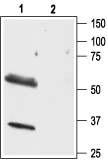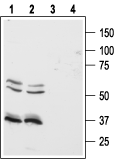Overview
- Peptide (C)RNWKRPSEQLEAQH, corresponding to amino acid residues 256-269 of rat OX1R (Accession P56718). 3rd intracellular loop.
- Rat and mouse brain lysate (1:200-1:500) and human colon cancer cell lines (1:200).
 Western blot analysis of mouse brain lysate:1. Anti-Orexin Receptor 1 Antibody (#AOR-001), (1:200).
Western blot analysis of mouse brain lysate:1. Anti-Orexin Receptor 1 Antibody (#AOR-001), (1:200).
2. Anti-Orexin Receptor 1 Antibody, preincubated with Orexin Receptor 1 Blocking Peptide (#BLP-OR001). Western blot analysis of rat brain lysate:1. Anti-Orexin Receptor 1 Antibody (#AOR-001), (1:500).
Western blot analysis of rat brain lysate:1. Anti-Orexin Receptor 1 Antibody (#AOR-001), (1:500).
2. Anti-Orexin Receptor 1 Antibody, preincubated with Orexin Receptor 1 Blocking Peptide (#BLP-OR001). Western blot analysis of human Colo-205 (lanes 1 and 3) and HT-29 (lanes 2 and 4) colon cancer cell lines:1,2. Anti-Orexin Receptor 1 Antibody (#AOR-001), (1:500).
Western blot analysis of human Colo-205 (lanes 1 and 3) and HT-29 (lanes 2 and 4) colon cancer cell lines:1,2. Anti-Orexin Receptor 1 Antibody (#AOR-001), (1:500).
3,4. Anti-Orexin Receptor 1 Antibody, preincubated with Orexin Receptor 1 Blocking Peptide (#BLP-OR001).
- Rat colon sections, human colon cancer sections (paraffin-embedded) (1:100-1:200) and rat brain sections (frozen), (1:100).
- Human colon cancer cell line Colo-205 (1:200).
Orexin Receptor 1 (OX1R) (also known as hypocretin receptor 1) is one of two receptors that recognize the peptide neurotransmitters orexin A and orexin B.1 Orexin A and B are 33 and 28 amino acids in length, respectively, and are derived from a common precursor termed prepro-orexin.
OX1R binds orexin A with greater affinity than orexin B (a one order of magnitude difference), while OX2R binds both ligands with similar affinities.2,3
Both OX1R and OX2R belong to the 7-transmembrane domain, G protein-coupled receptor (GPCR) superfamily.
OX1R is thought to transmit signals through the Ga11 class of G proteins, resulting in the activation of phospholipase C with subsequent triggering of the phosphatidylinositol cascade and an influx of extracellular Ca2+, probably through transient receptor potential (TRP) channels.2,3
The physiological functions of the orexin system (OX1R, OX2R, and their ligands) have been a matter of intense research in the last few years.
OX1R is expressed in both the central nervous system and peripheral locations such as gastrointestinal tissues, pancreas, and testis.2 It appears to be involved in the regulation of feeding behavior in rodents since an OX1R antagonist is able to inhibit baseline feeding.2,3
The orexin system has been shown to be involved in the regulation of sleep and wakefulness states and OX1R knockout mice show defects in the regulation of rapid eye movement (REM) sleep, among other phenotypic alterations.4 In addition, the orexin system is involved in regulating autonomic functions such as blood pressure and heart rate, as well as in mechanisms that regulate the reward response in the brain.4
